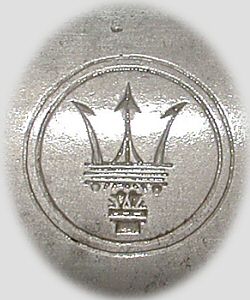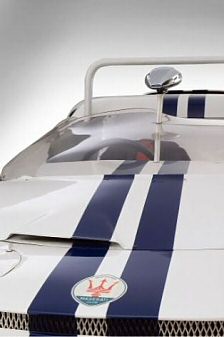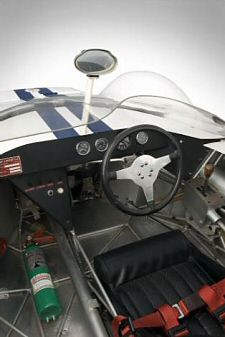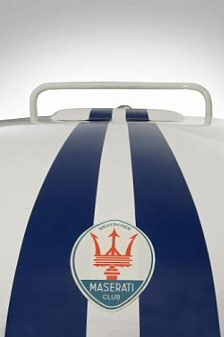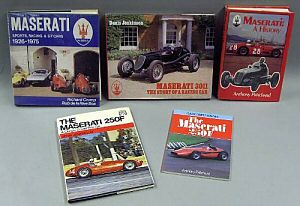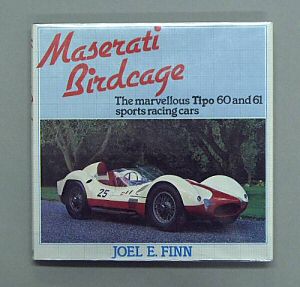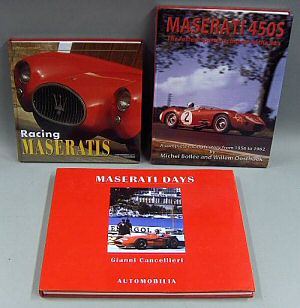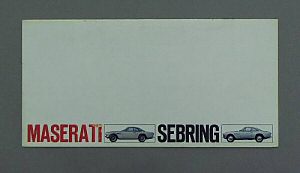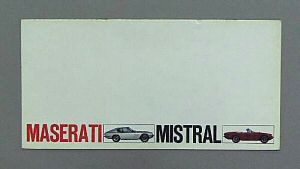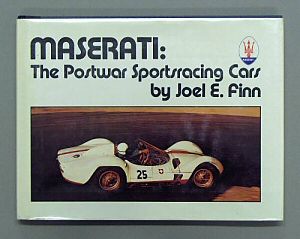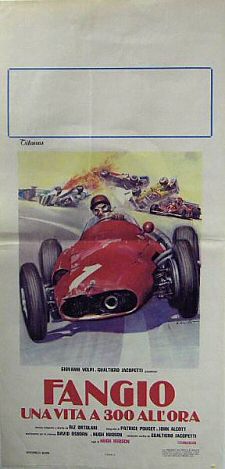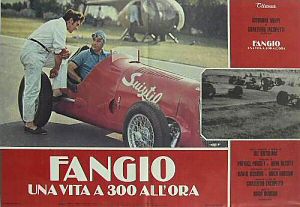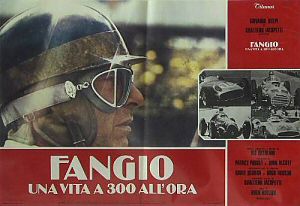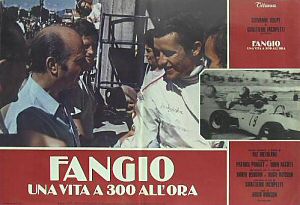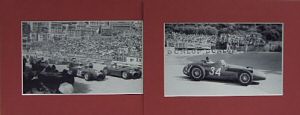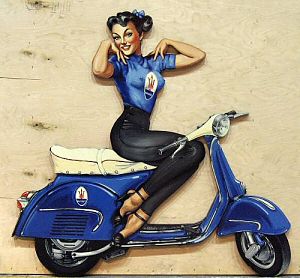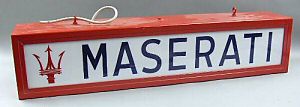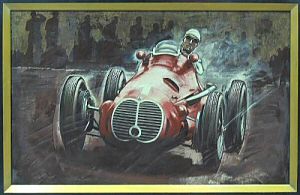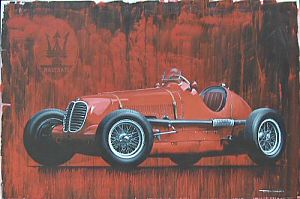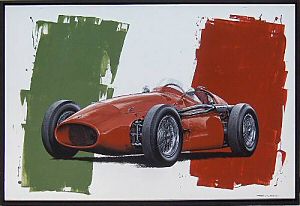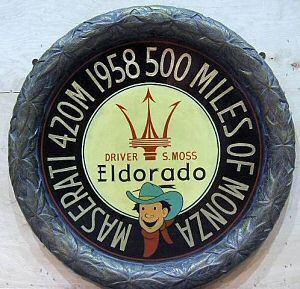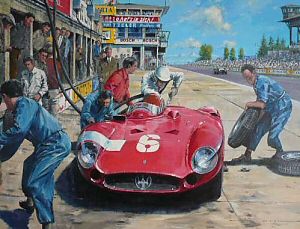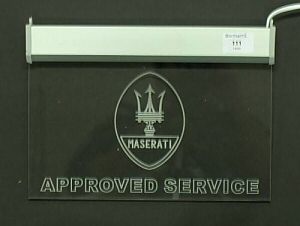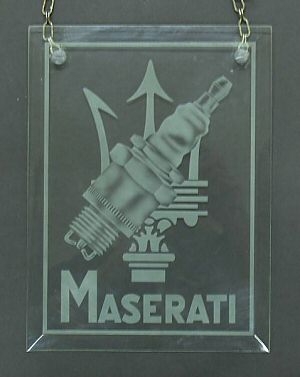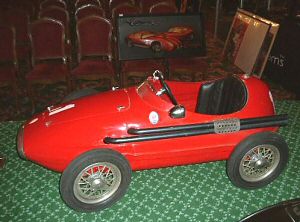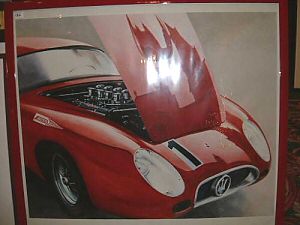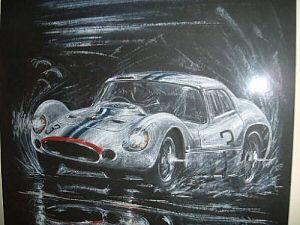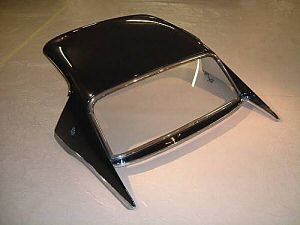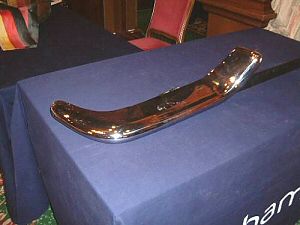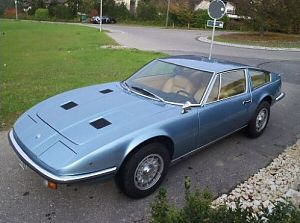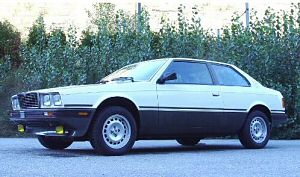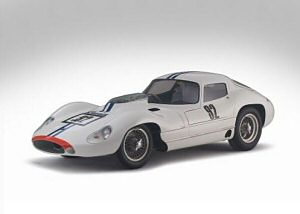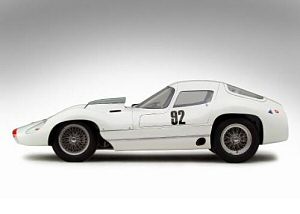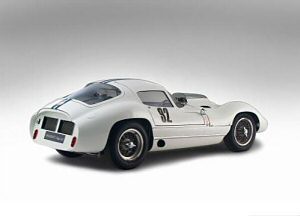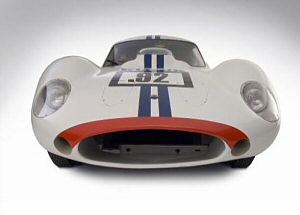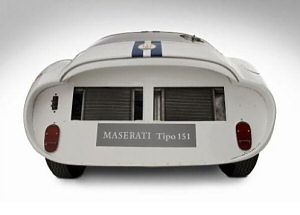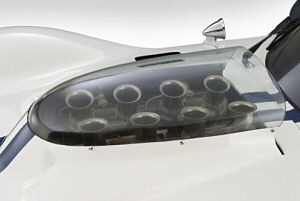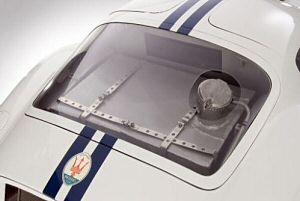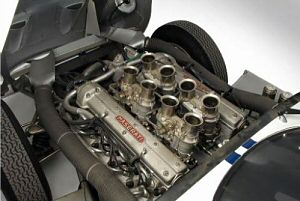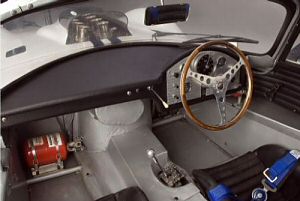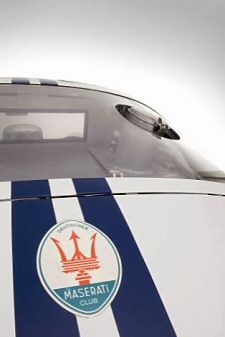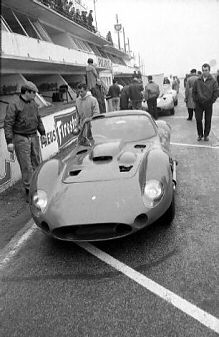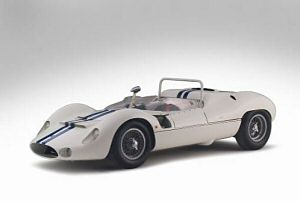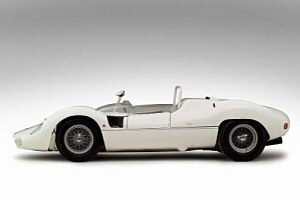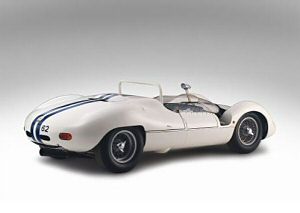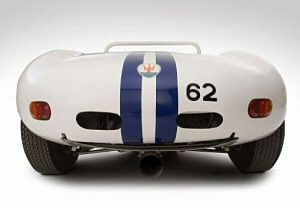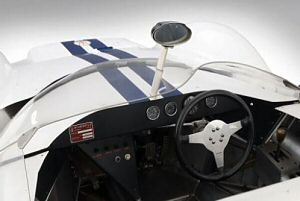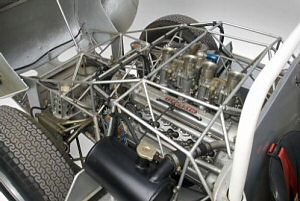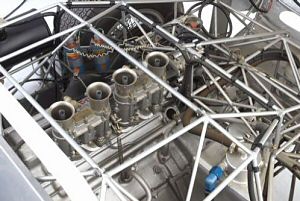Footnote:
This most attractively presented four-cylinder engined sports-prototype began life as nothing less than the most successful – in terms of race wins - of all the rear-engined ‘Birdcage’ cars built by Maserati between 1961 and 1965. It is the second long-wheelbase Tipo 63 built and the second to have been delivered to American millionaire sportsman Briggs S. Cunningham’s world-famous racing team. It was in his blue-striped white national colours that this chassis won the 1961 SCCA National event at Bridgehampton, Long Island, and then the Road America 500-Miles classic at Elkhart Lake, Wisconsin, driven on both occasions by the great veteran American road racing star, Walt Hansgen.
After its Cunningham team career it was returned to the Modena factory where it was consigned to long-term storage before being acquired as a rolling chassis in June 1965 by Californian-in-Modena, Tom Meade. He paid a reputed $850 for the engineless car, which appears to have been renumbered at that time as ‘63.021’. It is understood from the researches of Maserati historian Willem Oosthoek that, as recorded in his superb book ‘Maserati Tipo 63-64-65 – Birdcage to Supercage’ (Dalton Watson, 2004), “…Either Meade or the next owner, Brussels car dealer Léon Barbie, installed a 351 CID (5.7-litre) Ford V8 engine, a ZF gearbox and a conventional dashboard, this last feature making the car easy to identify”. Léon Barbie found a buyer for the Maserati-Ford in Armand Blaton who displayed it at the 1965 Brussels Salon de L’Automobile. Blaton
subsequently advertised the car for sale in the May 1968 issue of ‘Road & Track’ magazine in which it was misidentified as one of the Camoradi team cars which had been operated early in 1961 by Lloyd ‘Lucky’ Casner. The car was priced at $7,000 and it was bought by German collector Peter Kaus, who commissioned the Docking Spitzley racing team in England to restore it for him. The Alan Docking/Matt Spitzley team campaigned Formula 2 cars at the time and had been seeking a winter project to enable them to keep their mechanic team employed between seasons. The work was completed to Peter Kaus’s requirements, and the present 2.4-litre four-cylinder Maserati engine from a power boat was installed, driving via a Maserati five-speed transaxle.
The marine engine had been restored and prepared for automotive use by highly respected Aston Martin specialist engineer Rex Woodgate. It was claimed to produce some 215bhp. In fact in its original condition this chassis was powered by a 3-litre Maserati V12-cylinder racing engine, and that particular power unit – serial ‘63.010’ – is believed to survive to this day.
If we now trace the background history of chassis ‘63.010’ offered here, it was first completed by the Maserati factory in June 1961. It emerged at that time as a long-nosed, long-wheelbase Tipo 63 with toughened glass windscreen, V12 engine and what have become known as ‘gun turret’ exhausts, from the manner in which its four separate exhaust tailpipes emerged via slots in the car’s shapely rear fender sections.
The first of the new rear-engined ‘Birdcage’ Maseratis had made its debut on test at Modena on December 15, 1960. It was powered by a 2.8-litre four-cylinder engine, although Ing. Giulio Alfieri’s original Tipo 63 design had called for a new 2,930cc V8 power unit. Budgetary restrictions dictated, however, that as many components for the rear-engined car as possible should be drawn from the existing Tipo 60/61 front-engined ‘Birdcage’ parts store, and the V8 project was shelved. The first three Maserati 63s were then completed during March 1961, respectively, for Briggs Cunningham, for Count Giovanni Volpi’s Scuderia Serenissima and for ‘Lucky’ Casner’s Camoradi team. They used even-numbered chassis serials, ’63.002’-’63.006’. The American-owned cars competed in the Sebring 12-Hours race, while the Volpi car made its debut later in the Sicilian TargaFlorio. Masten Gregory led at Sebring in the Camoradi Maserati 63 which later retired with rear suspension failure, while Walt Hansgen/Bruce McLaren in the Cunningham car survived six hours before a cracked transaxle casing leaked all the
oil away, and the transmission seized.
Criticism from the new owners of the four-cylinder model led Ing. Alfieri to consider replacing it with the smoother-running 3-litre V12 engine, several of which were available at Modena, derived from the 1957 2.5-litre Formula 1 unit installed in 250F chassis. A prototype 3-litre Maserati 63 with 3-litre V12 engine installed was hastily completed in time for the Le Mans Test Weekend of April 8-9. Giorgio Scarlatti lapped in it faster than any of its four-cylinder sisters. His best time of 4mins 3.3secs was fourth fastest overall, bettered only by the front-engined Ferrari 250TRI/61s of Phil Hill and ‘Taffy’ von Trips and the works V6-engined Ferrari Dino 246SP of Richie Ginther. Where Ferrari had dared only to mount a V6-cylinder engine behind the driver in their posteriore-powered prototype, Maserati had made the leap and had mounted a 3-litre V12
there – two years before Ferrari would dare introduce their similarly-configured 250P design.
While the four-cylinder cars were used in the twisty-circuit Targa Florio and Nürburgring 1,000Km classics, Alfieri initiated a crash programme to upgrade the Tipo 63s to the 3-litre V12 engine for Le Mans. Two V12-powered cars were prepared for Briggs Cunningham, the re-engined short-wheelbase chassis ’63.002’ and the car now offered here – long-wheelbase chassis ’63.010’ brand-new.
It appeared at Le Mans for the 24-Hours race on June 10-11, 1961, wearing race number ‘6’, to be co-driven by New Zealand-born Formula 1 Cooper star Bruce McLaren and Cunningham’s former United States Road Racing Champion Walt Hansgen. In practice McLaren/Hansgen set third fastest lap time of 4mins 3.8secs, bettered only by the Ginther/von Trips Ferrari Dino 246SP and the Rodriguez brothers’ Ferrari 250TRI/61. Walt Hansgen ran third in the opening stages of the long race, and lay fourth in the early evening when rain began to fall. In those conditions he began to gain rapidly on the Ferraris ahead but on his 32nd lap – at 6.30pm – he slithered off into the sandbanks at Tertre Rouge corner, crushing the car’s nose and bursting its twin oil tanks. Hansgen attributed his accident to leaking oil smearing the windscreen which hampered his vision and eventually coating his front tyres which sent him off into the sandbank. The sister Cunningham Maserati V12 co-driven by Augie Pabst/
Dick Thompson, ran sixth after five hours, and despite lengthy pit-stops to change spark plugs finally finished fourth overall. The Serenissima Tipo 63 of Vaccarella/Scarfiotti overheated into retirement after 53 laps, a head seal having failed.
Walt Hansgen was officially clocked at 260km/h, 162.5mph, through the speed trap on the Mulsanne Straight, though it was by common consent sited in the wrong place – Hansgen seeing 270km/h – 168.7mph – beyond it. Meanwhile the short-wheelbase Tipo 63s into which the V12 engines had been shoe-horned were criticised by their drivers for being too cramped and uncomfortable. Consequently Briggs Cunningham returned his SWB car to the factory and had a long-wheelbase replacement produced, which inherited the original car’s chassis serial. This LWB chassis offered here was in contrast considered acceptable and was retained unchanged.
Willem Oosthoek’s researches indicate that the car’s chassis may have been renumbered ’63.011’ during its post-Le Mans rebuild, before being shipped back to Cunningham in New York with conventional exhausts fitted in place of the ‘gun turret’ devices. On August 16, 1961, the car was then driven by Walt Hansgen in the SCCA Bridgehampton National event, in which – as race number ‘60’ – the veteran fought a terrific duel with Roger Penske’s front-engined ‘Birdcage’ Maserati Tipo 61, beating it into second place by less than a second, and again tripping the main-straight speed-trap at over 160mph.
On September 10, the 5th Road America ‘500’ at Elkhart Lake saw Walt Hansgen and Augie Pabst co-driving ‘63.010’ offered here, under race number ‘61’ with a low-cut perspex windshield fitted. Pabst was able to take the car into the lead and by the time he handed over to Hansgen after 85 laps the Maserati held a whole lap advantage. Hansgen rejoined with a 43 second lead over Penske, eventually taking the chequered flag after 125 laps and 6hrs 5mins racing. This Alfred Momo-prepared Cunningham Maserati Tipo 63 had displayed outstanding speed and reliability in face of strong opposition.
On October 15 it was then driven by Augie Pabst in the Riverside Consolation event, failing to finish due to a fire. During practice at the Californian desert circuit its original 2,989cc V12 engine had failed, and had been replaced for the Consolation race by the 2,985cc short-stroke unit taken from the team’s sister long-wheelbase chassis ‘63.002’. It was after this event that the car was returned by Cunningham to the Italian factory in November 1961.
Here we offer this most historic rear-engined ‘Birdcage’ Maserati eligible to compete in all manner of current Historic events with its four-cylinder engine ready installed but equally poised to be reunited by some kind new owner with the type of 3-litre V12-cylinder engine used in its heyday. Cunningham team Maseratis very rarely come to public auction, and here we are delighted to offer the most successful of the rear-engined breed. |
| |
 |
| |
Lot No: 209
1969 Maserati Maserati Mistral 4.0-Litre Spyder
Coachwork by Carrozzeria Frua
Chassis no. AM109SA1717
Estimate: CHF130,000 - 160,000.
Sold for CHF175,000 plus Premium and tax. |
| |
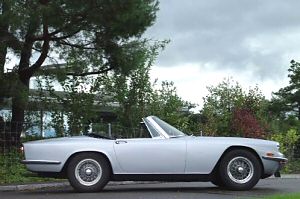
|
| |
‘We do not suppose there are many cars whose names conjure up an aura of exotic glamour to the same extent as that of Maserati. Even now, many years after the company has withdrawn from any form of competition, past glories linger on.’ - Sporting Motorist.
Maserati’s survival strategy for the 1960s centred on establishing the company - which hitherto had mainly concentrated on its Grand Prix and sports car racing activities - as a producer of road cars. The Modena marque’s new era began in 1957 with the launch at the Geneva Salon of the Touring-bodied 3500GT. A luxury 2+2, the 3500GT drew on Maserati’s competition experience, employing a tubular chassis frame and an engine derived from the 350S sportscar unit of 1956. Suspension was independent at the front by wishbones and coil springs, while at the back there was a conventional live axle/semi-elliptic arrangement. Power output of the gorgeous twin-cam six was around 220bhp initially, later examples producing 235bhp.
Last of these classic six-cylinder Maseratis, the Pietro Frua-styled Mistral commenced production in 1963. The 3.7-litre version of the Bolognese manufacturer’s long-stroke engine was fitted to most cars, other options being the 3.5-litre or, from 1966, the 4.0-litre unit. A handsome two-seater on a shortened, square-tube chassis, the Mistral was built in coupé and spyder versions, the former’s opening rear window hatch making it an unusually practical car. A five-speed gearbox, disc brakes and fuel injection were standard equipment; automatic transmission, air conditioning and a limited-slip differential the options. Production ceased in 1970, by which time a total of 827 coupés and 123 spyders had been built.
This 4.0-litre Spyder was delivered new in Bologna, Italy on the 27th June 1969. The car was exported temporarily to Germany on 3rd April 1974, it is believed for some maintenance work, before being UK registered in August 1975 by Jerome Harrington, of London. Mr Harrington kept the car in the UK for one year, after which he took it to Cannes and sold it to Mr Jurg Weber, of Bern, Switzerland who kept it for 25 years. In 2000 Mr Weber sold it to a Mr Girardin, of Bienne, Switzerland, who fitted a new soft-top and had the interior re-trimmed by Claude-Alain Boss, of Neuchatel. Some mechanical refurbishment was carried out by M & R Beutler, of Bienne before Mr Girardin sold it (at auction) to the current owner in 2003. The latter gave the car to Bjarsch in Zurich, Maserati specialists since the 1950s, who carried out extensive refurbishment which was completed in 2005 at a cost of 13,700 CHF (detailed invoice available). Possessing continuous and documented history from new, this rare Mistral Spyder is offered with Swiss Carte Grise. |
| |
 |
| |
Lot No: 211
1977 Maserati Khamsin Coupé
Coachwork by Carrozzeria Bertone
Chassis no. AM120-1262
Estimate: CHF55,000 - 70,000.
Sold for CHF68,000 plus Premium and tax. |
| |
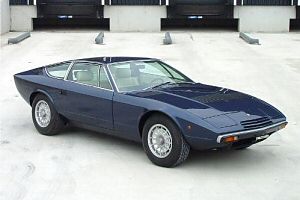
|
 | 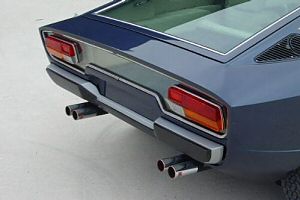
|
| |
Maserati’s final major introduction while under Citroën’s control, the Khamsin (named after a hot Sahara Desert wind) debuted at the 1972 Turin Show and entered production in 1974. Styled and built at Bertone, the Khamsin’s attractive, unitary-construction, 2+2, hatchback body was of all steel construction. The front-engined Khamsin featured state-of-the-art, all independent, double-wishbone suspension similar to that of the mid-engined Bora and Merak which, combined with a 50/50 front/rear weight distribution, endowed the Khamsin with near perfect balance; and if its grip level was ultimately inferior to the Bora’s, then the Khamsin’s conventional layout made it easier to control close to the limit.
Citroën’s hydraulic technology (as found in the Maserati-engined Citroën SM) was employed to power the brakes and steering - the latter, in particular, being rated as highly effective by testers - and also to raise the concealed headlamps. The power unit was a longer-stroke, 4.9-litre version of Maserati’s familiar quad-cam V8 developing 320bhp at a lowly 5,500rpm and a lusty 354lb/ft of torque at 4,000 revs. A five-speed ZF manual gearbox or three-speed Borg-Warner automatic transmission were options, and when equipped with the former the Khamsin was good for around 240km/h (150mph). Although seemingly less exotic than the mid-engined Bora supercar, the Khamsin was Maserati’s biggest-engined and most expensive offering at the time of its introduction, and thus could justifiably claim to be its top-of-the-range model. By virtue of its front-engined layout, the Khamsin offered greater practicality, providing a roomier and more comfortable interior and superior luggage carrying capacity.
‘Just as it scores in terms of accommodation compared with a mid-engined car, so the Khamsin is generally quieter,’ observed Autocar magazine. ‘There is an exciting noise of cams in motion when the car is accelerating hard, but this is presumably no more than the enthusiastic owner would demand. There is very little of that tiring noise that nags away at the occupants when cruising at a high steady speed. In these circumstances the engine noise dies away to a whisper and wind noise never becomes apparent.’
A mere 430 examples of this most exclusive and consummate Grand Routier had been made when production ceased in 1982.
One of the best examples we have ever offered for sale, this Khamsin was delivered new to the USA and imported from there into Switzerland in 1990 and extensively restored (to European specification) in Germany over the course of the next two years. The beige interior and the blue carpets are in excellent condition. The engine runs well and the ‘Citroen’ brakes are efficient. The vendor advises us that Swiss taxes have been paid (documents available) but the car has never been registered in Switzerland or in the UK. The car will be delivered with the old American Title and the documents stating import duty has been paid. The vendor has confirmed that he will arrange for the car to be registered in Holland in January 2007. |
| |
 |
| |
Lot No: 214
The Ex-Maserati France, Jo Siffert/Jochen Neerpasch, Le Mans 1965 Maserati Tipo 65 Sports-Racing Prototype
Chassis no. 65.002
Estimate: CHF650,000 - 950,000.
Sold for CHF840,000 plus Premium and tax. |
| |
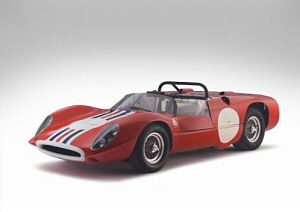
|
 | 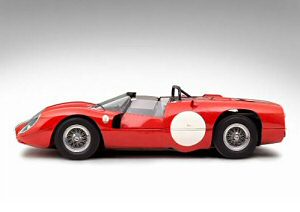
|
| |
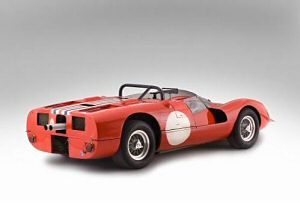
|
 | 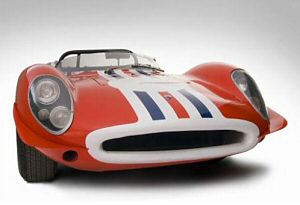
|
| |
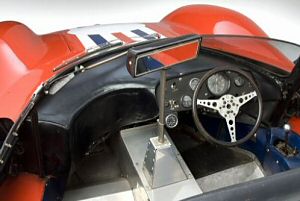
|
 | 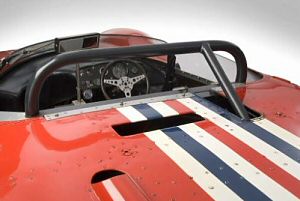
|
| |
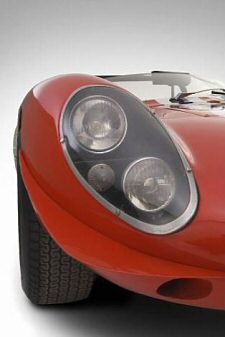
|
| |
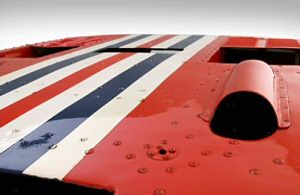
|
 | 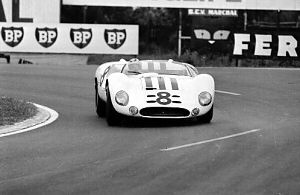
|
| |
Footnote:
This remarkably imposing V8 rear-engined sports-prototype is the last of the long line of Maserati competition cars built during the Gruppo Orsi empire’s long ownership of the Italian marque. As such it marks the high tide of their development right through the wide range of A6GCS, 150, 200, 250, 300, 350 and 450S sports-racing classics, through the famous ‘Birdcage’ Tipo 60-64 models and the big V8-powered 151 Berlinetta designs of 1962-65.
The fatal accident to Maserati France driver ‘Lucky’ Casner in the ultimate Maserati 151/4 Coupé during the Le Mans test weekend of 1965 left the company’s still enthusiastic patron, American-born Colonel Johnny Simone, with no entry for the 24-Hours endurance classic. He knew that in the Modena factory there was a spare 5,044cc V8 151/4 engine available, but now without a chassis to accommodate it. Ingegnere Giulio Alfieri had a design prepared for a more refined version of the Tipo 63/64 ‘Birdcage’-chassised open-cockpit sports-prototype theme, and in May that year Col. Simone commissioned Maserati to go ahead and build him a hybrid version of it, to be powered by the 5.1-litre 4-cam V8 unit. Sponsorship came from BP France and with Le Mans only six weeks ahead work began in a rush on this Tipo 65 car.
Alfieri directed that an obsolescent Tipo 63 chassis frame be drawn from the factory’s famous ‘mortuary’ store of potentially useful scrap. This chassis is believed to have been the long-wheelbase serial ’63.008’ – replacement for a short-wheelbase Tipo 63 using the same serial number – which had first been completed at the Maserati factory during April, 1961
.
In original form it had been supplied to the youthful Venetian Count Giovanni Volpi di Misurata’s Scuderia Serenissima racing team. It was powered by a 4-cylinder 2,980cc engine and had been campaigned in the 1961 Targa Florio by Nino Vaccarella/Maurice Trintignant, finishing fourth overall. In May that year it had been co-driven by Vaccarella/Trintignant and Giorgio Scarlatti in the Nürburgring 1,000Kms, but failed to finish. It appears that the chassis was then stripped of all useable mechanical parts and consigned to the Maserati factory’s redundant-parts store.
Once retrieved for the Maserati France Le Mans programme of 1965, this chassis frame was cut in half and placed back upon the chassis jig, where a new rear section was constructed and welded into place behind the existing rear cockpit bulkhead, while the front section was also extensively modified to Alfieri’s latest requirements. Where the original four-year old Tipo 63 had weighed a total 780kg, this new V8-engined Tipo 65 would turn the scales at nearer 1,200kg.
Much wider new ‘doughnut’ racing tyres were available in 1965 than had been produced in 1961, and where the original Tipo 63’s front and rear track widths had been 1250 and 1200mm respectively, the new Tipo 65’s were to be 1400 and 1370mm. The new car offered insufficient space for a de Dion-type rear axle as used on all preceding ‘Birdcage’ series cars and the 151 Coupés, so the Tipo 65 was equipped instead with wishbone rear suspension sprung by torsion bars. As on the preceding Tipo 151 Coupés, the V8 engine was equipped with dual ignition, a Bosch alternator and a Lucas dynamo, each fully interchangeable. Two sill-mounted fuel tanks plus a third in the passenger side of the cockpit provided a combined capacity of 154 litres.
Having taken such a flying-start by cannibalising the old Tipo 63 chassis’ centre-section, this new car was completed from Col. Simone’s commission in just thirty days, and it emerged weighing some 160kg more than the ill-fated Tipo 151/4 Coupé which it replaced. Maserati described its 5,044cc 4-cam V8 engine as developing no less than 430-bhp at 7,000rpm. It drove via a five-speed plus reverse transaxle and was geared for a maximum speed of some 320km/h (195mph).
The car was tested by Guerrino Bertocchi and the great Umberto Maglioli at the Modena aerautodromo and at Monza, with its new Spider body work still, in bare aluminium, unpainted. It was then sprayed overall white with red/blue/red centreline stripes, and was taken off to France on June 14, 1965, with just five days to go before the target Le Mans 24-Hours classic.
At the last moment prior to the great race Col. Simone had secured the services of Swiss Formula 1 privateer Josef ‘Seppi’ Siffert, together with Porsche works team newboy Jochen Neerpasch. The French driver Jean-Claude Vidilles was retained as reserve. Works mechanics in attendance with the car were Guerrino Bertocchi himself – the factory’s veteran chief mechanic and test driver – Rino Ragazzi, Cleto Grandi and Giancarlo Martinelli. The Tipo 65 had received the merest minimum of testing.
Le Mans scrutineering revealed a forward weight distribution of 532kg, rearward 668kg. Jochen Neerpasch’s first-practice session lap time of 4 mins 4.9secs was 17th fastest. Four additional cooling scoops were opened in the nose. Jo Siffert then clocked 4mins 3.0secs in the second session, but others had also improved, leaving this unique Maserati 21st fastest overall.
Jo Siffert took the start, sprinting across to the long white-painted Maserati, leaping in, firing-up that big V8 engine and wheel-spinning away right-handed into the day-long race. In fact he made a brilliant start and the Tipo 65 was fourth entering the Esses on that opening lap, headed only by the Ford GTs of Chris Amon, Bob Bondurant and Bruce McLaren. But the works Ferrari P2s, Jochen Rindt’s NART-entered Ferrari LM and Dan Gurney’s Cobra Daytona were quickly into their stride and as the pack streamed back past the pits to begin lap 2, Siffert and this latest Maserati lay eighth.
Through the Esses and down to the right-hander at Tertre Rouge, opening out onto the Mulsanne Straight, Siffert came under pressure from Innes Ireland’s Ford GT, and the Swiss ex-racing motorcyclist entered the corner too fast, spun, and crashed into the straw bales lining the inside of the course. His car bounced off with its nose radiator punctured. Siffert succeeded in limping it back to the pits, but leaked coolant all the way. Under the Le Mans regulations it was forbidden to replenish fluids until at least 25 laps had been completed, and consequently the heart-broken Maserati crew were left with no alternative but to retire their thirty-day wonder after less than ten minutes’ racing…
This car was returned to Modena for repair, and was modestly updated with a view to possible further competition, the rear suspension torsion bars being replaced by coil-springs and the front suspension modified with long-stroke Koni dampers. Even a fresh dash panel was fitted. Some 90kg were shed from its overall weight, and the repaired nose section was shorter than the original. But the car remained at the factory in storage – unraced – through the mid-1960s. In 1966 it featured as
stag-dressing in the background of an Italian spy movie. Then in 1967 young Austrian enthusiast Egon Hofer – from Salzburg – expressed interest in racing the car for Col. Simone in suitable European Group 7 sports car races. The head of Maserati
France agreed, and Hofer took delivery of the car on July 29, 1967. However, on August 23 Col. Simone and his wife, French movie star Junie Astor, were both killed in a tragic head-on collision with a heavy lorry near Avallon while motoring from Paris to Nice in his Maserati Mistral Coupé. Egon Hofer abandoned all plans to return the Tipo 65 to racing, and offered instead to sell the car for Simone’s surviving heirs, brother George and sister Charlotte.
In March 1968 it was acquired by Swiss collector Hans Schertenlieb. He commissioned body modifications including a new nose, twin headlights, additional air-scoops on both front and rear fenders, the cars’ second new dashboard and outsize tyres – the panel work being carried out by Carrozzeria Drogo in Modena.
Mr Schertenlieb soon passed the car on to its original Le Mans driver, Jo Siffert, for his personal collection in Fribourg. When poor ‘Seppi’ was subsequently killed in the Formula 1 BRM at Brands Hatch in October 1971, the Tipo 65 was sold from his estate to Englishman Bob Owen, racing secretary of the Historic Sports Car Club (HSCC). With added roll-over bar and cut-out fenders it was raced regularly by Mr Owen in suitable British events, and at Oulton Park – driven by Willie Green – it competed fiercely with a Lola T70.
Bob Owen eventually sold it to Sid Colberg of Anglo-American Automobile Investments, and it was advertised for sale by English dealer Chris Stewart in December 1978. It was bought at that point by German collector Peter Kaus, who retained it as one of the stars of his Rosso-Bianco Museum at Aschaffenburg for the following 27 years.
This remarkable and still plainly potent grand finale to the Orsi years of Maserati competition is offered here as displayed at Aschaffenburg. As such it will plainly require expert inspection and preparation before any attempt is made to run it again in earnest. It is undeniably the genuine article. It is unique. It is ex-Le Mans, and ex-Maserati France/Jo Siffert/Jochen Neerpasch. It is the last word in the Ing. Alfieri line of ‘Birdcage’ Maserati development, and it is available right now to the highest bidder – right here in Gstaad. |
| |
 |
| |
Lot No: 215
1995 Maserati Ghibli ‘Open Cup’ Coupé
Chassis no. 00361226
Engine no. 870026
Estimate: CHF120,000 - 180,000.
Sold for CHF45,000 plus Premium and tax.
|
|
| |
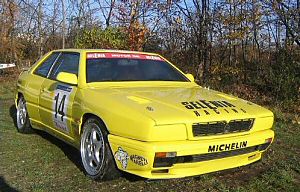
|
| |
First applied to its fabulous, Ghia-styled supercar of the 1960s, Maserati revived the ‘Ghibli’ name for an ultra high performance Biturbo variant in the 1990s. Introduced in 1992, the Ghibli 2.24v came with a 24-valve version of the 1,996cc Biturbo V6 engine, while a six-speed manual gearbox and limited-slip differential were standard equipment on this luxuriously equipped supercar.
One of just 1,133 examples produced between 1992 and 1997, this left-hand drive Ghibli 2.24v was used to contest the 1995 Ghibli Open Cup, a relatively low-cost, one-make race series held over eight rounds at some of Europe’s premier venues. The series’ Technical Regulations specified that the engine, turbochargers, gearbox and differential must be sealed by the manufacturer before the car’s delivery to the customer, and no operation other than ordinary maintenance of these components was permitted. Any tuning was forbidden and exotic fuel mixes banned. Along with the strictly limited number of tyres available, these rules ensured an exceptional equality in performance as well as tight control of costs. Maserati’s technical staff were on hand throughout the season to assist competitors with set up and preparation.
Ghibli Open Cup chassis number ‘00361226’ was once owned by Italian Maurizio Sconti, who competed with this car in the Selenia Maserati Ghibli Open Cup Championship during the 1995 season, eventually finishing 8th overall in the final general classification (full results list available). After Sconti missed the last race at Magny Cours, the Ghibli was placed in storage, effectively disappearing until a court in Bologna announced details of its sale by auction. The car was quite dirty but in practically the same condition as last raced in 1995. It still had its race number, ‘14’ and even the differential and electronic management system remained sealed by Maserati.
‘00361226’ had covered fewer than 1,500km at that time and was sent by its new owner to well-known specialist Guiseppe Candini’s workshop, close to Carozzeria Campana in the outskirts of Modena. Candini’s experience dates back to Maserati’s 1950’s heyday, when he was mechanic to World Champion Juan Manual Fangio, working on the latter’s 250F. Candini has been entrusted with many high profile restoration projects, including Tipo 420M/58 Eldorado, various 5000GTs, the 16-cylinder Tipo V4 engine, A6G/2000s, A6GCS and many more.
At Candini’s, the engine, gearbox, clutch, turbos and electrical wiring were checked and all worn parts replaced. The suspension was removed, cleaned and readjusted, as were the brakes, while the body received careful surface treatment wherever necessary and was returned to perfect shape.
Having previously owned two Ghibli Open Cups (‘00361228’ and ‘00361230’), the vendor purchased ‘00361226’ in the autumn of 2005, since when it has formed part of his private collection of Maseratis but not been used. The car was checked over again in 2006 and found to produce 330bhp on the dynamometer. Fastidiously maintained, it has had only one outing since, for a photo shoot, but has not been used on either road or track.
Of the 1995 season’s original 22 Ghibli Open Cups, not more than 15 survive and ‘00361226’ is almost certainly the last remaining in the ’95 series configuration. It is unspoiled, never crashed and in practically ‘showroom’ condition – the odometer currently shows a mere 1,600km from new. A standard road Ghibli in this condition would be an exceptional find, so it is all the more remarkable to discover such a well preserved Ghibli Open Cup, the car that marked Maserati’s successful racing comeback after so many years’ absence from the racetracks.
Offered without reserve, ‘00361226’ comes with ‘Certificate of Origin’ from Maserati SpA verifying its originality. |
| |
 |
| |
Lot No: 216
1962 Maserati 3500 Spyder
Coachwork by Carrozzeria Vignale
Chassis no. AM101 1353
Estimate: CHF220,000 - 250,000. |
|
| |
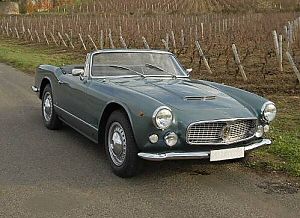
|
| |
Despite numerous racetrack successes that included Juan Manuel Fangio’s fifth World Championship - at the wheel of a 250F - in 1957, Maserati was by that time facing a bleak future. Its parent company's financial difficulties forced a withdrawal from racing, and Maserati’s survival strategy for the 1960s centred on establishing the company as a producer of road cars. The Modena marque’s new era began in 1957 with the launch of the Touring-bodied 3500GT, its first road car built in significant numbers. A luxury 2+2, the 3500GT drew on Maserati’s competition experience, employing a tubular chassis frame and an engine derived from the 350S sportscar unit of 1956. Suspension was independent at the front by wishbones and coil springs, while at the back there was a conventional live axle/semi-elliptic arrangement. The 3500GT’s designer was none other than Giulio Alfieri, creator of the immortal Tipo 60/61 ‘Birdcage’ sports-racer and the man responsible for developing the 250F into a World Championship winner. The twin-overhead-camshaft, six-cylinder engine was a close relative of that used in the 250F and developed around 220bhp initially, later examples producing 235bhp on Lucas mechanical fuel injection. Built initially with drum brakes and a four-speed gearbox, the 3500GT was gradually improved, gaining five speeds, front disc brakes and, finally, all-disc braking.
A car possessing such impeccable antecedents not unnaturally attracted the attention of Italy’s finest carrozzeria: Allemano, Bertone and Frua all created bodies for the 3500GT chassis, while most coupes were the work of Touring. Vignale, whose star designer was then Giovanni Michelotti, was responsible for all but one of the less-common Spyder version. Introduced in 1959, the latter was built on a slightly shorter wheelbase - 250cm as opposed to 260cm - and lasted in production until 1964, by which time just 245 cars had been made.
Chassis number ‘1353’ is the 185th Spyder built and was delivered new to the Mipi company in Italy in January 1962. A desirable five-speed model, it was manufactured with fuel injection but has since been fitted with carburettors, a common modification carried out in the interests of both improved performance and practicality. The car remained in Italy until 1990 when it was bought by the 3rd owner who commissioned its complete restoration, which was undertaken by Italauto in Holland between 1995 and 2000. A comprehensive file of invoices and pictures of the restoration accompanies the car. Finished in blue/green with superb black leather interior, this wonderful Italian thoroughbred is offered with Maserati build certificate and German registration papers. |
| |
 |
| |
Lot No: 217
The Ex-Rosso Bianco Collection
1964-type Maserati Tipo 151/3 Sports-Racing Berlinetta
Chassis no. 151.002 (number quoted on chassis plate affixed to dashboard, see text)
Estimate: CHF250,000 - 350,000.
Sold for CHF250,000 plus Premium and tax. |
|
| |
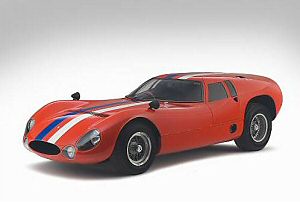
|
 | 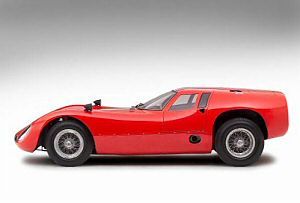
|
| |
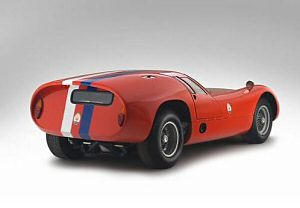
|
 | 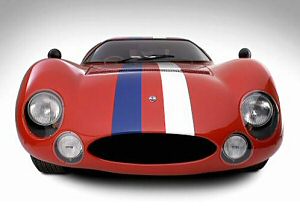
|
| |
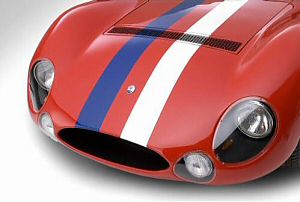
|
 | 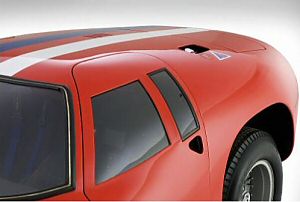
|
| |
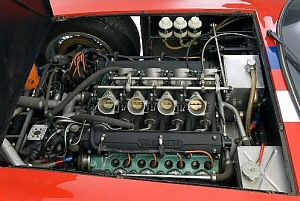
|
| |
Footnote:
This remarkable project, paying homage to perhaps the most rare of all postwar competition Maseratis, is offered here as an expression of the tremendous enthusiasm and dedication shown by German collector and Maseratista Peter Kaus over so many years in his Rosso Bianco Collection at Aschaffenburg. The original prototype that this car reproduces actually originated
as far back as 1962 as the first of the 4-litre V8-engined Maserati 151 Coupé cars, entered at Le Mans and Brands Hatch by the ever-enthusiastic Colonel Johnny Simone’s Maserati France organisation. At Le Mans in 1962 the car was co-driven by Maurice Trintignant and Lucien Bianchi, and for 1963 the same chassis was updated as the Maserati 151/1 variant equipped with a Lucas fuel-injected 4,941cc wet-sump V8 engine with bore and stroke dimensions of 94mm x 89mm, developed a claimed 430bhp at 7,000rpm.
Driver André Simon was immensely quick in this red-liveried car with its white and blue centreline stripes, setting the fifth fastest practice time during the opening session at the Sarthe circuit, with a time of 3 mins 58.0 secs and clocking the highest speed of 291km/h – 181mph – through the Mulsanne Straight speed trap. In second practice he lapped in 3:56.8, and was then delayed at the start of the 24-Hour race because the heat of the sun had glued the driver’s door shut onto its rubber sealing strips! André Simon had to wrench it open at the third or fourth attempt, and then it slammed into his face, cutting his nose quite badly…
Simon was eleventh through the Dunlop Curve immediately after the startline, but at the end of the Mulsanne Straight he slid into second place, led by only Phil Hill in the Aston Martin Project 215 Coupé. When the former World Champion ran over debris from a crashed car and called at the Aston Martin pit after five laps, Simon inherited the lead, and he held it from all the factory Ferraris at the end of the opening hour. After two hours the Maserati 151/1 still led, now with ‘Lucky’ Casner having taken over from Simon but on the car’s 40th lap the transmission failed, and the car was retired.
It reappeared in the Reims International Trophy race preceding the French Grand Prix, driven by Simon, and then finished eighth in the Trophée d’Auvergne 3-Hour race at Clermont-Ferrand, driven by Lucien Bianchi. In the Guards Trophy race at Brands Hatch in England it finished a troubled 13th, again entrusted to Bianchi, after which it was returned to the Modena factory to be completely reworked. Its original-style rakish bodywork was removed and the chassis was used as the basis for what Ing. Alfieri listed as the Tipo 151/3 design while Col. Simone christened it the Tipo 152. The original body still survives today, and it being restored to running order with a replacement chassis and suitable engine and running gear
refitted. It is not, therefore, to be confused with the differently-bodied tribute car being offered here.
Meanwhile, the basic ‘151.002’ chassis’ wheelbase was lengthened from 2350mm to 2400mm and both front and rear track widths were widened by 100mm. New 15-inch Borrani wire wheels were adopted, fitted with the latest wide-profile Dunlop Racing tyres. The 5-litre fuel-injected engine was converted to dry-sump lubrication and persuaded to yield an extra 20bhp, totalling 410. A simplified yet extremely spectacular-looking aerodynamic Coupé body was designed for the car by Piero Drogo and fashioned by Mario Allegretti and his craftsmen. The car was run at the 1964 Le Mans Test Weekend and André Simon and Maurice Trintignant lapped in 3 mins 56.1 secs and 3:58.0 respectively. Guerrino Bertocchi subsequently achieved 315km/h –
196mph – in the car on the Modena-Bologna Autostrada, and reported that high-speed wandering was no longer a problem. During testing at Monza, however, André Simon crashed at 250km/h due to a right-hand rear wheel collapse.
The damage was quickly repaired and the car presented at Le Mans, liveried in red with broad centreline stripes in white and blue. Practice there was beset by problems with the bodywork fouling the tyres, and on the opening lap of the race Trintignant found the throttle fouled and he pulled into the Maserati France pit where a block of sponge rubber was found jamming the throttle slides. The French veteran returned to the fray lapping at the same pace as Richie Ginther’s leading rear-engined Ford GT!
After an hour’s racing Trintignant and the Maserati 151/3 was back up to 17th place, and after two hours it lay tenth. André Simon became the first driver ever to exceed 300km/h through the Mulsanne speed trap during the 24-Hour race – clocking 310.2km/h – 192.6mph. After three hours the Maserati was seventh, and after five Trintignant/Simon had grabbed third place. But as dusk fell, the Maserati’s lights gave trouble, its brakes were failing, and just after midnight the car had to be withdrawn due to an untraceable electrical short-circuit.
Col. Simone then entered his 151/3 in the Reims 12-Hours – to be driven again by Trintignant/Simon and the big Coupé ran sixth until its engine began to misfire during the fourth hour. Alternator problems dogged the car and the use of single ignition, instead of the dual ignition employed in previous years, cost the team dear. They had to withdraw the car after 6hrs 55mins racing.
On October 11, 1964, the Paris 1,000Kms race at Montlhéry saw the Maserati France bolide out again with Trintignant/Simon co-driving, and the former powered the big car into fourth place at the 20-lap mark, before being forced to stop due to a broken condenser wire. The pounding meted out by the frost-heaved Montlhéry banking would ruin Maserati’s chances, however, and on lap 50 the 151/3 was out with its oil-pump bracket broken.
Col. Simone remained determined, however, to demonstrate the ageing front-engined car’s continuing worth, and back at the works in Modena two fresh and enlarged dry-sump, fuel-injected V8 engines were prepared for the 1965 season – one of 5,055cc developing around 450bhp for Le Mans practice and the other of 5,044cc giving some 430bhp for the race. Dual ignition was re-adopted, with one system fed by distributor, the other by magneto as in 1962. Fuel tankage was increased from 139 litres to 160, and front suspension was redesigned to accommodate huge inboard Girling disc brakes. The body shape was refined around the tail, and the car was repainted white with red and blue centreline striping. Maserati classified this further revised
car the Tipo 151/4, while Simone dubbed it the Tipo 154.
The 1965 Le Mans Test Weekend began on Saturday, April 10. ‘Lucky’ Casner was to drive the car for Col. Simone, with Masten Gregory as co-driver. However, the unfortunate Casner lost control just after the final hump on the Mulsanne Straight, the superfast Maserati crashed into trees and the American was killed instantly, the car destroyed, and the wreckage subsequently scrapped.
The great car in its 1964 form fascinated German collector Peter Kaus, and in 1980 he was able to borrow from the Modena factory the surviving manechino body buck defining the shape of that year’s Maserati France Le Mans contender – the 151/3. This body former had been employed by Allegretti to shape the 1964 body panels to the Drogo Coupé style, and now it was re-used by Allegretti to recreate the body in more or less its original 1964 form for Mr Kaus. This new body was then mounted upon a chassis made in Germany, and fitted with a Tipo 54 marine V8 engine located in Italy. This car – effectively Peter Kaus’s tribute to Col. Johnny Simone, Maserati France and the last roofed-in hurrah of the Orsi-Maserati story at Le Mans – is now offered here in all its most considerable glory. |
| |
 |
| |
Lot No: 225
1956 Maserati A6G/2000 Allemano Coupe
Coachwork by Carrozzeria Allemano
Chassis no. 2147
Engine no. to be advised.
Estimate: CHF140,000 - 180,000.
Sold for CHF202,000 plus Premium and tax. |
|
| |
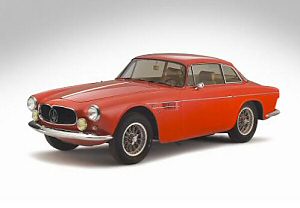
|
 | 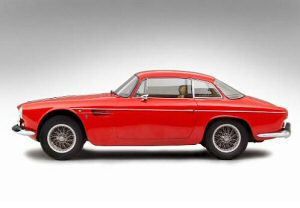
|
| |
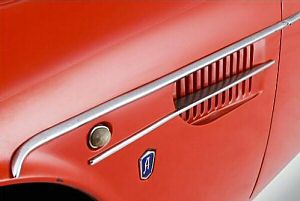
|
 | 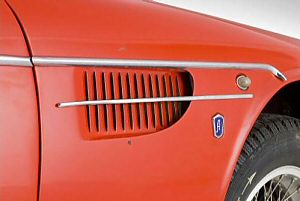
|
| |
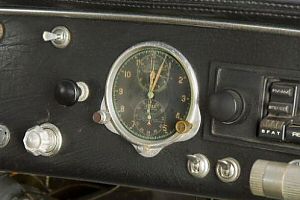
|
 | 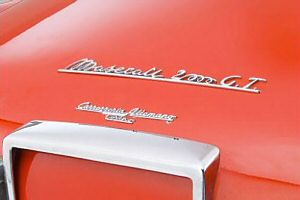
|
| |
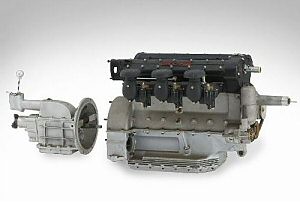
|
| |
This particular Maserati model originated in 1954 as the ‘A6G/54’, the ‘A6’ designation having first been used for a 1.5-litre six-cylinder car in 1950, and is typical of the early series-production road cars that created a firm commercial foundation for the legendary post-war Modena marque. The year 1954 year was, in fact, a pivotal one for Maserati as it also saw the introduction of the company’s superb 250F Grand Prix car, which would go on to feature in two of the great Juan Manuel Fangio’s five Drivers’ World Championship titles. Maserati’s A6GCS sports-racing car also achieved widespread success and praise in addition to the emergence of this new production Granturismo model. With its new six-cylinder twin-overhead camshaft design, Maserati clearly had an eye on a customer market seeking to combine everyday road-going practicality and quality with occasional competition activities.
The first A6G/54 made its debut at the 1954 Paris Salon, wearing coupé coachwork by Carrozzeria Frua. The A6G engine was an in-line six-cylinder with twin overhead camshafts and bore/stroke dimensions of 76.5x72mm for a displacement 1,986cc. Equipped with three twin-choke Weber carburettors - available in a variety of specifications - it delivered a claimed 150bhp at 6,000rpm. Dry weight for the A6G/54 was around 840kg (1,848lb) and maximum speed in the region of 195-210km/h (120-130mph).
The A6G/54 and later A6G/2000 were the Maserati company’s mainstream production Granturismo models of the mid-1950s. Several examples of the type were to enjoy successful competition careers, wearing bodies designed and fashioned in the metal by Carrozzeria Zagato, Allemano and to a more limited degree by Frua. Allemano, Carrozzeria per Automobili, Torino was chosen to complete the later A6Gs after Maserati clients had criticized the Spartan nature of the earlier Zagatos and the somewhat quirky styling of the Frua bodies. Allemano’s was the most soberly attractive of the styles associated with the A6G, its elegant and unobtrusive lines being conceived and executed by the specialist company run by Serafino Allemano from 1927 to 1965, latterly working with his grandson Mario. Allemano became highly regarded by Maserati for the accuracy of its work ‘responding to the philosophy of a highly prestigious grand touring car’. Total production of these A6G/2000 née A6G/54 models - the latter designation having been dropped as manufacture continued through 1955 and ’56 - appears to have run to around 60, although no two cars were entirely alike.
Ex-USA and subsequently ex-Germany, this A6G/2000 previously formed part of the famous Rosso Bianco Collection. The engine and gearbox are currently out of the car (we recommend that prospective purchasers take the opportunity to inspect both units) while the body and interior appear generally sound, although showing signs of age. Needing work before its enjoyment can recommence, ‘2147’ represents a rare opportunity to acquire a stylish Granturismo from an historic and respected marque, eligible for a wide variety of prestigious historic motoring events. |
| |
 |
| |
Lot No: 228
1984 Maserati Biturbo Coupe
Chassis no. ZAM 331B 00EB 108399
Estimate: CHF10,000 - 15,000.
Sold for CHF5,000 plus Premium and tax. |
| |
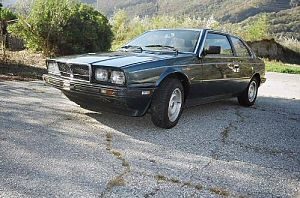
|
| |
Maserati’s mainstream model throughout the 1980s and the first series-production road car to employ a twin turbo-charged engine, the Biturbo debuted in two-door form 1982. Intended to challenge BMW and Mercedes-Benz in the luxury sporting saloon market, the Biturbo was of conventional, front engine/rear drive layout and featured all-independent suspension, four-wheel disc brakes, and an interior boasting sumptuous leather upholstery and plentiful wood veneer trim. The all-steel unitary chassis/body was styled in-house and built by Innocenti, part of the De Tomaso empire like Maserati. ZF five-speed manual and three-speed automatic were the two transmission options, while a limited-slip differential came as standard. Produced initially with a 2-litre, three-valves-per-cylinder, 90-degree V6, the Biturbo gained 2.5-litre, 2.8-litre and four-valves-per-cylinder engines as the model range expanded throughout the 1980s to include four-door saloon and open-topped spyder variants.
The 2.5-litre unit was the first addition to the range of engines and like the 2.0-litre original was an all-alloy, two-cam V6 with three valves per cylinder, the two inlets being different sizes to promote efficient cylinder filling over a wide rev range. Turbo lag, a not uncommon problem with this form of forced induction, was addressed by using two small IHI turbochargers rather than a single large one, fed by a solitary Weber carburettor. In this form the Biturbo engine produced 192bhp (DIN) and 220lb/ft of torque when installed in the two-door saloon, figures good enough for a top speed in excess of 130mph.
Currently in the hands of its second owner, this 2.5-litre, V6-engined Biturbo was supplied new via official Maserati agents Loris Kessel AG in Lugano, Switzerland to first owner Mr Armando Albisetti. Finished in blue with tan leather interior, the car has covered circa 69,000 kilometres from new and comes with stamped service book, Contrôle Technique and Swiss Permis de Circulation. Offered without reserve. |
|
| |


